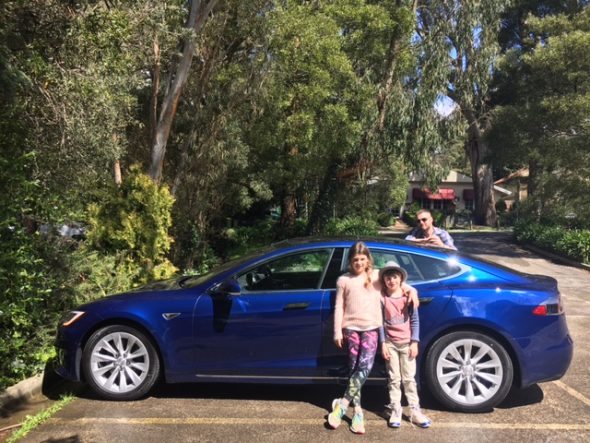In late September, I managed to get my hands on a Tesla Model S 75D electric vehicle for a long weekend, from Thursday afternoon to Monday morning. Here’s what I learned from my three-day experience of pretending it was the family run-about…
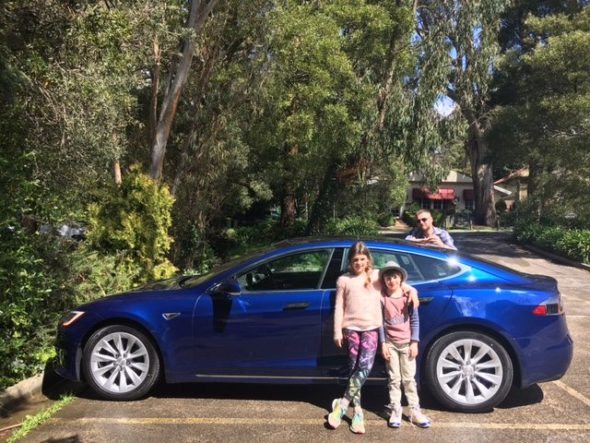
First, though, a couple of declarations and disclosures:
1. When I say there is nothing ludicrous about using a Tesla electric vehicle as the family car, I am certainly not counting the ticket price, which for the Model S 75D I was driving sits at between $130,000 – $170,000. This, of course, is well beyond the means of most average families. (That said, it’s not exactly unusual to see brand new prestige wagons and four-wheel drives populating our local school’s drop-off zone.)
My focus in this story is on the practicalities of using a fully electric vehicle as the family car. And while my test subject happened to be the Model S, the lessons learned could be applied to Tesla’s more reasonable Model 3 (set to be sold in Australia for around $60,000) and other lower end EV models and makes.
2. The Model S 75D used for this story was loaned to me by Tesla’s Melbourne crew in Richmond.
3. I am obviously not an auto writer, and my experience with prestige cars, or even “new” cars, of any technological denomination is seriously limited, so I will try my hardest not to get carried away with features that come as standard in most modern cars. Like sun-roofs and sat-nav! And I did not test Tesla’s auto-pilot function.
First impressions
While the Tesla Model S is a Seriously Fancy Car, driving a high-end electric vehicle was not nearly as “otherworldly” an experience as I had expected – although you could probably spend a couple of days getting acquainted with the multitude of touchscreen features alone.
Yes, the torque is amazing (no, I did not try to race a jet plane), and yes, it is very, very quiet. But it drives and feels remarkably normal and comfortable, so much so that you can almost forget you are driving around something worth the same as a small house. It also feels – and by all reports is – very safe.
Range anxiety
When we picked up the car on Thursday afternoon, it had a full charge of around 420km. After the drive home (30-40 mins in traffic), a few laps of the block impressing various friends, family and neighbours (15 mins), a trip to a restaurant for dinner (1 hour round trip) and then a family drive to the Dandenong Ranges the next day (2 hours round trip) we had barely used up 100km of range. …And then I stopped checking.
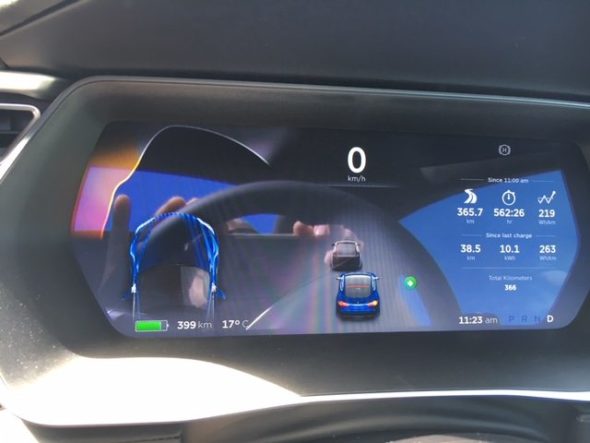
Just like that, the range anxiety disappeared. Perhaps it is all that training with the mobile phone. It’s not hard to see how someone like me, who rarely drives anywhere further than one hour away, could use an electric vehicle day in and day out and – like a mobile phone – plug it in every night, without really having to think too much about it. And no petrol stations!
Of course, home charging can be slow – Tesla’s home charging solution provides up to 10kW of power to any Model S, and you’ll get 47km of range per hour from it – but this would not be a problem for most people whose cars are in their garages for most of the night. And most of the time it would not be a full charge that was required, but a top-up.
In our case, we have no off-street parking, so chose to recharge the car – although we didn’t really need to – using a Supercharger at Tesla’s Richmond HQ on Sunday morning, when there was about 100km of battery range left. This took around 20 minutes and was free.
As Choice notes, Tesla’s network of free Supercharger stations are a major bonus for Tesla owners, who are generally expected to make use of them once a week. For long trips, forward planning is required, but making a 20 or 30 minute stopover to re-charge the car and stretch the legs doesn’t seem unreasonable and could even be a good idea, OHS-wise.
Things that take getting used to
No key: Well, there is a key, and in the case of the Model S it’s a super cute miniature Tesla, but that turns out to be kind of a pain when you have a 7 year-old who is mad about playing with matchbox cars. That aside, the key doesn’t have anywhere to go when you are driving the car, which I found took a bit of getting used to. I was terribly paranoid about losing it. I note that in other EVs and, for example, in my sister’s (not electric but diesel) Volvo, the key is no longer used to start the car – there’s a button for that – but it does go in a designated slot when you drive, making it easy to keep track of.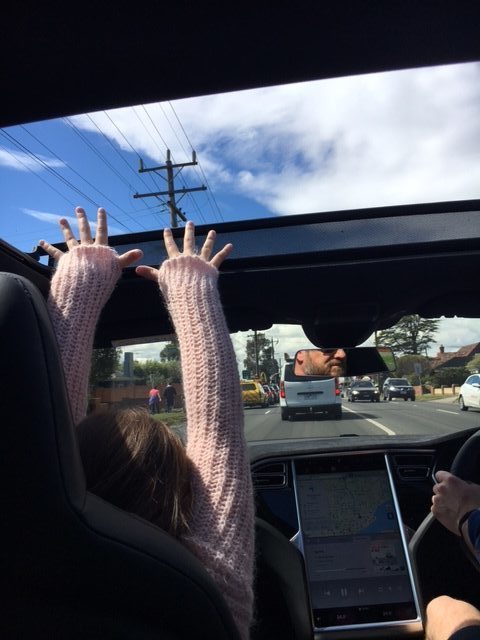
Magic key and door handles: While it’s terribly clever that the key just has to be in the general vicinity of the car to open it automatically, it also takes some getting used to, particularly with the retractable door handles. We had a few comical moments where we waited for the door handles to present themselves, and they didn’t; and one near miss where the door handle retracted back in with 7 year-old’s fingers still on it. No harm was done, but it’s probably not an ideal feature for a family car.
Regenerative braking: This, too, takes a little getting used to – but not much. And for drivers who are unfamiliar with the feature – which has the effect of slowing the car automatically once you start to take your foot off the accelerator – there is the option to adjust the settings to “low” or even switch it off to “neutral”.
We started on low, but quickly switched to “standard” and found it to be an intuitive and safe feature – it almost makes it hard to be a bad driver, particularly around corners and in stop-start traffic. And it saves on brake pad maintenance, considering you only really need to use the actual brake pedal when you come to a complete stop.
The big screen: While the huge digital interface that dominates the centre console of the Model S has some fabulous features – in this case including Spotify, which the kids treated as their own personal Jukebox. The car’s sound system is great. – it can be pretty distracting for the driver, and potentially dangerously so. Perhaps this becomes less the case after time, and perhaps we had not spent enough time mastering it before we started driving. But it occurred to us that, for the uninitiated, using it was not unlike driving while fiddling with your mobile phone, which is, of course, not allowed.
That said, all you need to know while driving, including your proximity to other vehicles on the road, is also displayed on the dash behind the steering wheel (see image above), the latter of which also has all the important controls on it. So you don’t have to use the touch screen if you don’t want to while driving.
The gear stick: Like the old “three on the tree” of the Ford XW I once owned, the Tesla has its “gears” – that is, Park, Drive, Neutral, Reverse – and its “ignition” on an unassuming lever on the right hand side of the steering wheel. This would not be a problem for most, but for some – people who are, say, used to driving a 2004 Subaru Outback wagon – it takes some getting used to the fact that this is where the indicator lever used to be, and the indicator lever is now on the other side. On one occasion, instead of indicating a left turn I wound up putting the car into neutral. But it only happened once, I swear.
Things to note
While we had a good experience with the range on our Model S 75D, our friends at Tesla did warn us beforehand that range performance has a good deal to do with how fast you drive the car, as well as how far you drive it. Going over 100km/h depletes the battery faster, as does racing jet planes in ludicrous mode. We didn’t have cause to do either.
It should also be noted that it takes a decent chunk of electricity to re-charge an EV, particularly one with a 75kWh battery pack. While all available evidence and reports suggest this still works out cheaper than petrol, diesel or even gas, it must be noted that charging an EV on a daily basis will, in turn, add a decent chunk to the household electricity bill.
According to Choice, topping up the charge of a Model S would take 51 minutes and use 8.3kWh for a cost of $2.06 a night. And if, for example, a Tesla owner topped up their car at home six nights a week and used a Supercharger station on the seventh, Choice estimates this would cost $12.36 a week for up to 280km of driving, or over a year, $642.72 for more than 14,500km.
This can be further mitigated by charging at night (off peak) or by installing solar. Other deals to look out for are free EV charging at work, or specially targeted retail deals like that recently offered by AGL Energy, of $1 a day “all you can eat” EV charging.
Space
There is heaps – heaps – of space in a Model S, including a huge boot (trunk) and a smaller space under the engine-free bonnet (Tesla calls this space a “frunk” or “front trunk”). More than enough for my family of four – and for a “big shop” (pictured below). However, the word from Tesla is that the more affordable Model 3 won’t be quite as roomy and perhaps not roomy enough for a family of four or five, depending on your needs and circumstances.
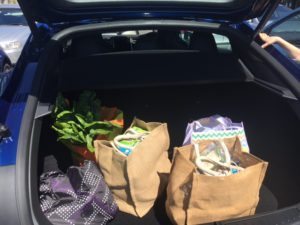
Costs
Looking past the higher ticket price, the annual cost of servicing an EV should work out to be very competitive with ICE vehicles, due to the comparatively small number of moving parts in EVs – and because the regenerative braking saves on brake pads.
The cost of eventually replacing the battery, however, is a different matter. According to Choice Magazine, Tesla’s global website estimates replacing a Model S 85’s battery to be $US12,000 ($AU15,799). Of course, Elon Musk’s plan, with the Gigafactory, etc, is that this cost will fall far and fast. So it’s one to watch.
This article was originally published on RE sister site One Step Off The Grid. To sign up for the weekly newsletter, click here.

